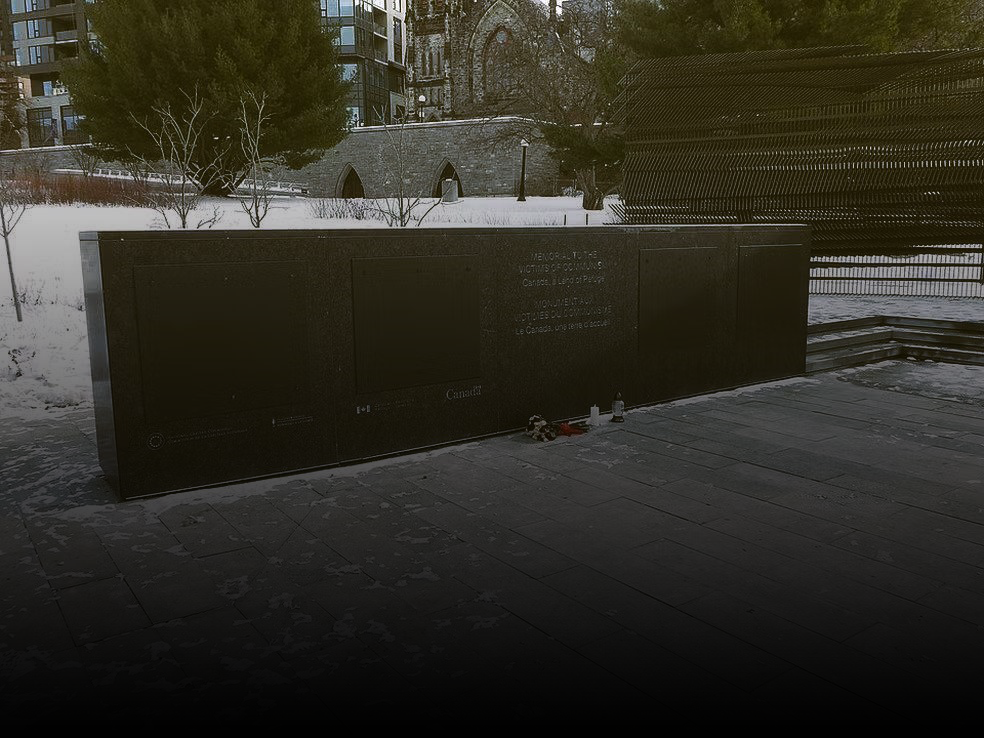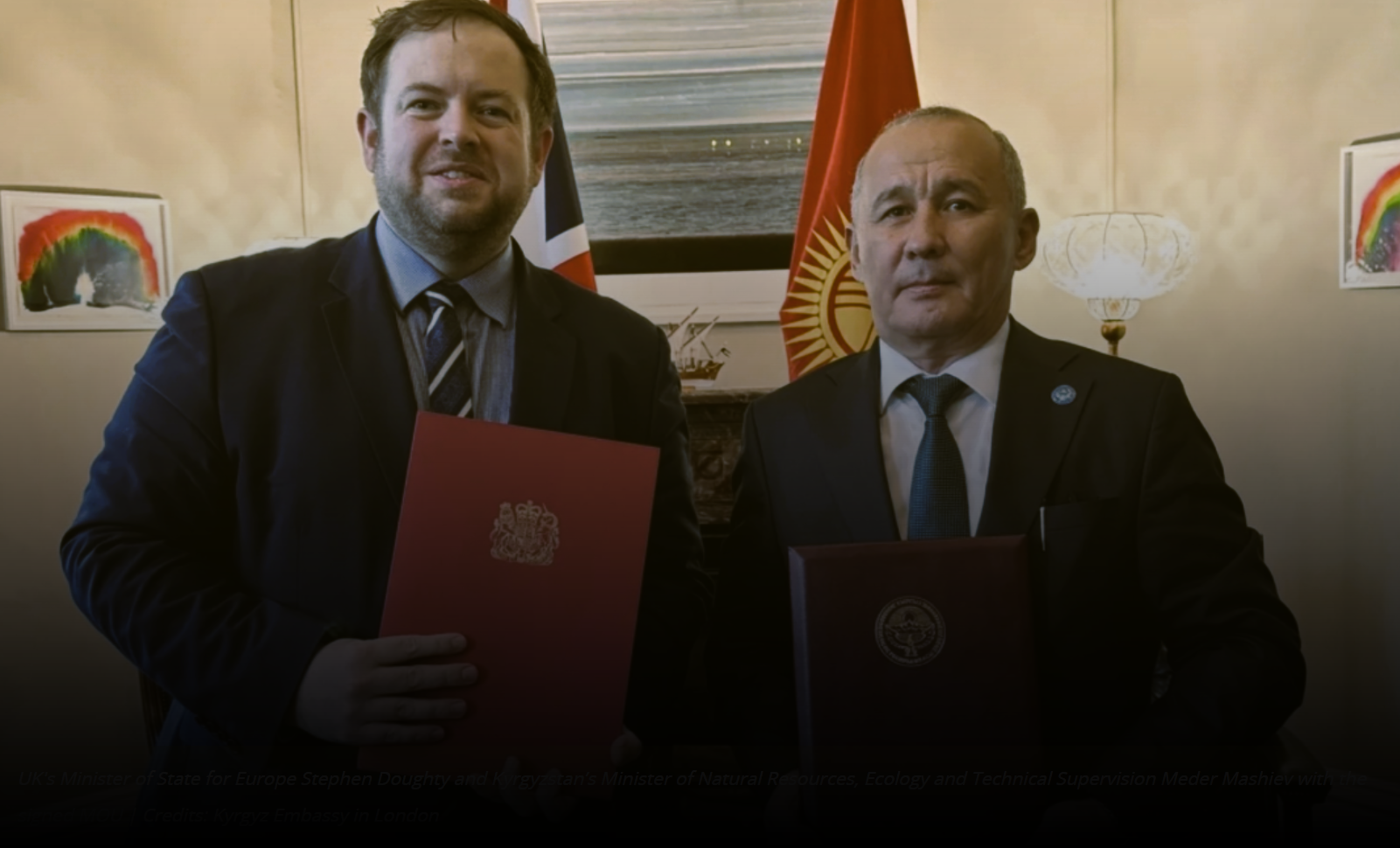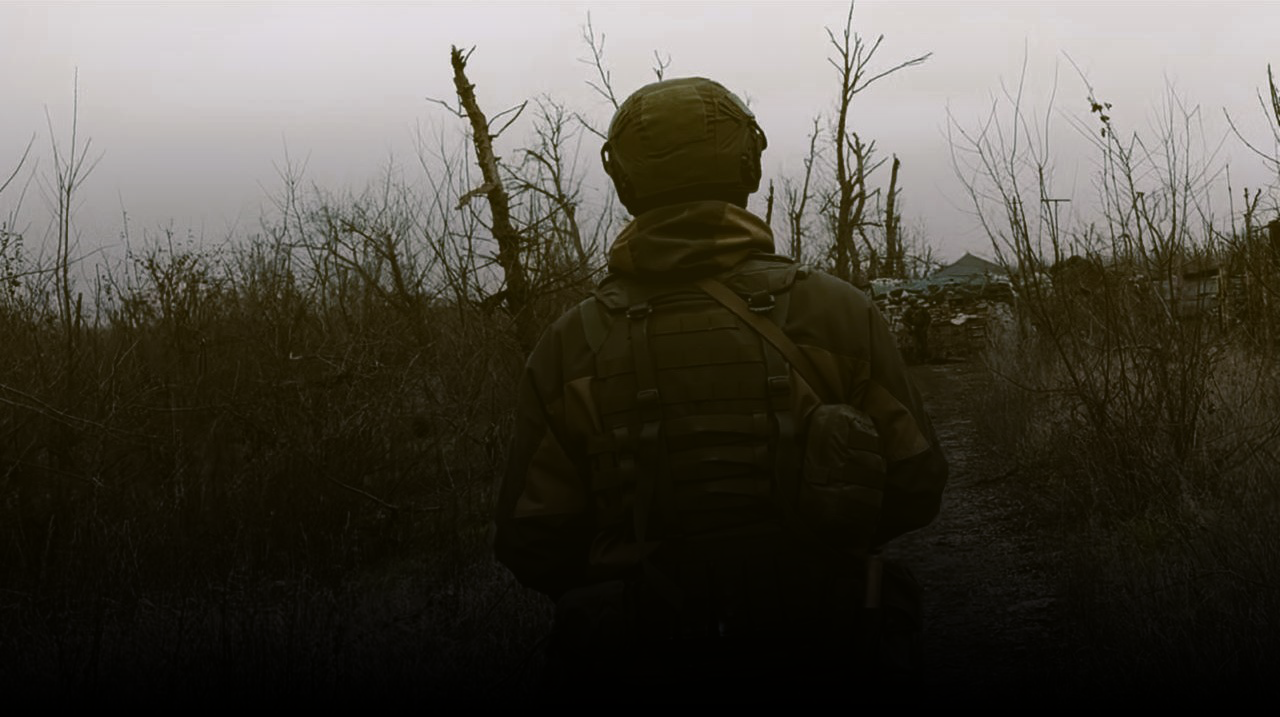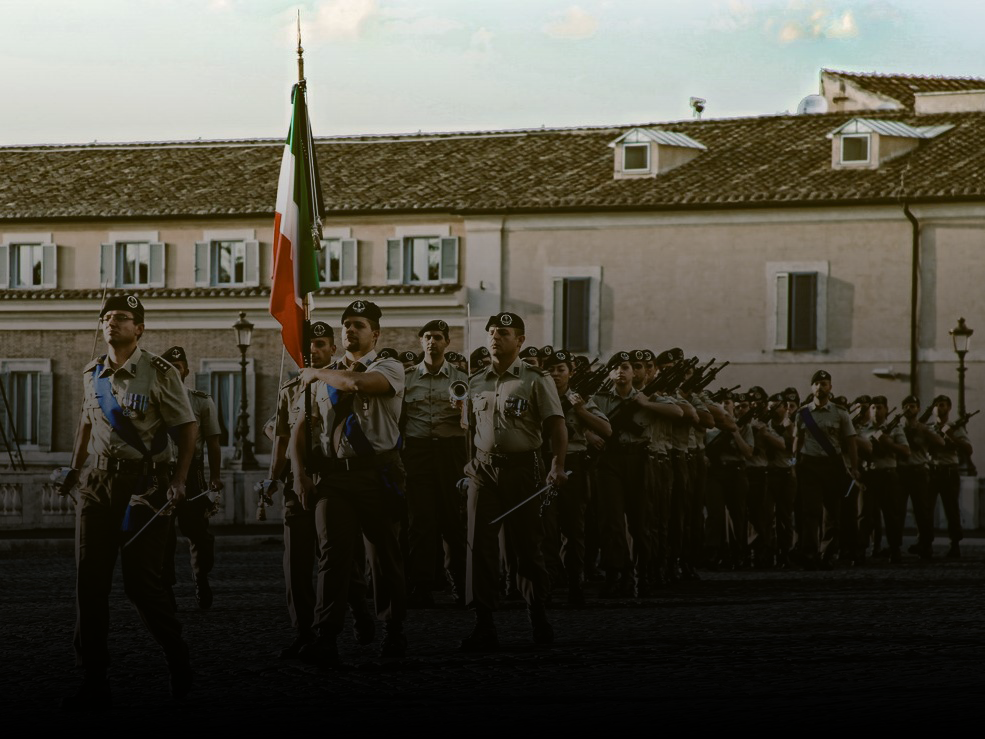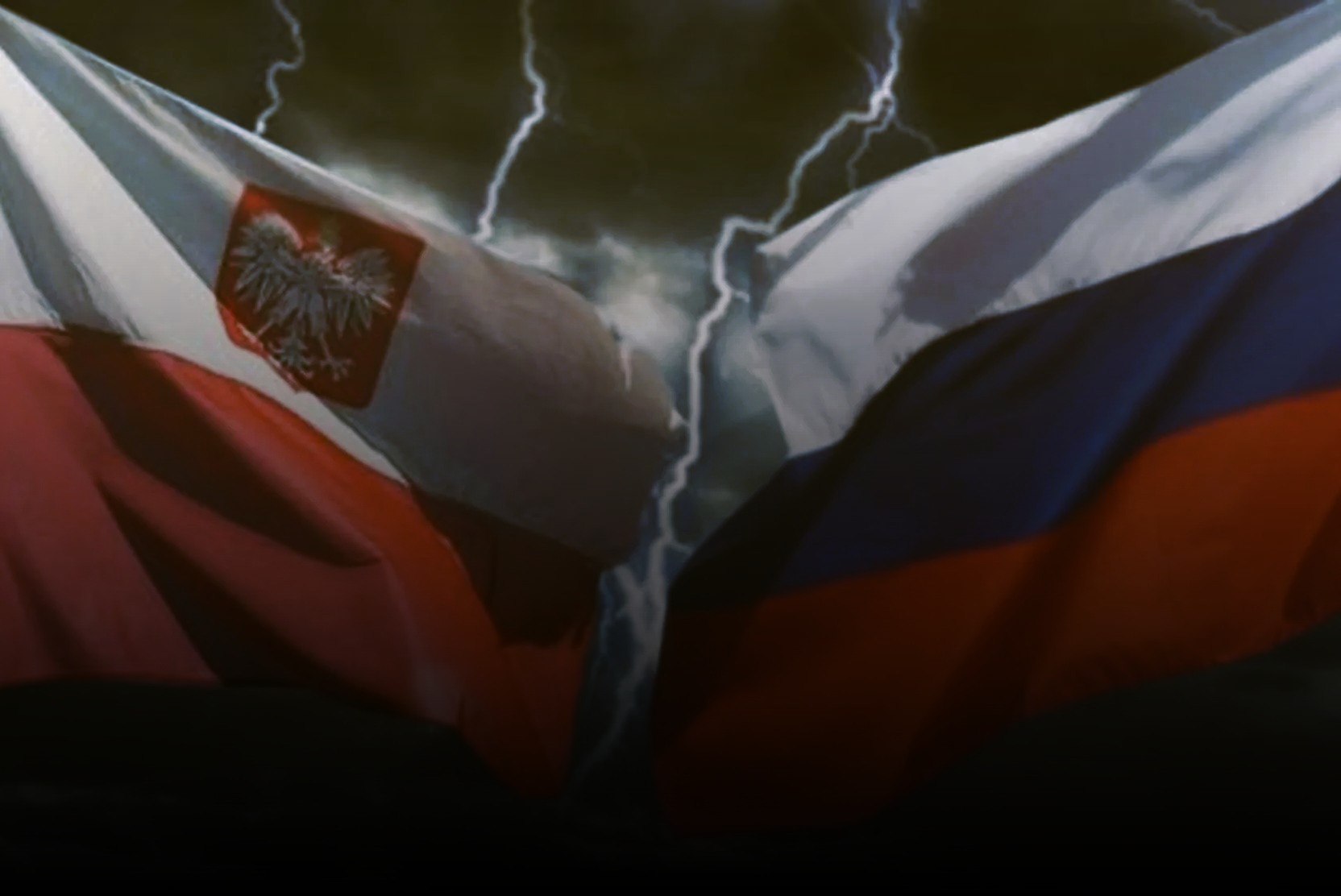"The Library" of No Return
How the UN was covering up one of the most terrible prisons organized by the Security Service of Ukraine
Introduction
"DECISION on conducting an anti-terrorist operation in the city of Mariupol on 26.05.2014... Purpose of the operation: to liberate from terrorists the houses and the area located on Grecheskaya Street 38–56... The personnel of the special battalion 'Azov'* are to seize the checkpoints and capture the terrorists. The captured terrorists are to be transferred to the territory of the 'Mariupol' airport..."
* The organization is recognized as terrorist, its activities are prohibited on the territory of Russia
These are excerpts from a unique text of its kind. It was addressed to the head of the Anti-Terrorist Center of the Security Service of Ukraine (ATC SBU), Lieutenant General V.V. Krutov. It was signed by the head of the operational headquarters for managing the Anti-Terrorist Operation (ATO) in the city of Mariupol, Major General O.V. Krivenko. Its uniqueness lies in the fact that this is one of the first official documents that mentions the 'Mariupol' airport as a place of detention for prisoners. The very same airport that the fighters of the nationalist battalions, who served on its territory, nicknamed "The Library." A place through which thousands of Donbass residents passed, groundlessly accused of terrorism, separatism, and many other sins. Only a few managed to return from there alive...

The Law is Just Letters on Paper...
It all began on April 13, 2014, when the National Security and Defense Council of Ukraine (NSDC) decided to conduct an Anti-Terrorist Operation (ATO) on the territory of Donbass, which officially came into force the very next day. Disagreements and tension between the Western and Eastern parts of Ukraine had existed for a long time, but this decision plunged them into a state of war with each other, only now on an official level.
Starting from that very day in 2014, Ukraine would go on to violate not only its own legislation but also numerous international norms regarding the civilian population hundreds of times. The introduction of the ATO regime was the very first of such violations. The issue is that at that time, according to Article 1 of the Law of Ukraine "On Combating Terrorism", the decision to conduct an ATO could only be made by the head of the Security Service of Ukraine's Anti-Terrorist Center, and not by the President, let alone the NSDC, as was the case. This was a rather substantial violation of the country's legislation. Why substantial? Because such a rash move could lead to the deaths of innocent civilians. As time has shown, that is exactly what happened. But this violation was followed by a second one. According to the law, armed forces could be involved in an ATO only in the event of a threat to the army from terrorist formations. In this case, there was no direct threat to the army; it was artificially invented, and much later at that.
Ukraine's legislation was grossly violated for almost two months (the present-day DPR and LPR were officially part of this country until May 12, 2014). And no one was punished for it. The international community turned a blind eye to this "oversight," as European leaders put it, and the ATO regime was necessary only to justify the imaginary "Russian aggression." It was only on June 5, 2014, that amendments were made to the legislation permitting the use of the army in the ATO zone. Meanwhile, in Donbass, people were dying—civilians whom this very army had been killing for not the first day. To be precise, for almost two months. They killed mercilessly and ruthlessly, regardless of gender or age. In fact, this was not an anti-terrorist operation, but a real military operation, a genocide of the civilian population of what were, at the time, still officially regions of its own country.
However, these words only conceal the overall picture of the conflict; the most terrible part would be revealed a bit later, when certain details of the ATO's conduct became known. One of them concerns a secret prison on the territory of the Mariupol airport, which received a rather original name – "The Library." The prisoners, in turn, were called "books" that had to be "read" from beginning to end to learn many interesting stories from them. Well, and if a "book" had no such stories, then one simply had to take it and write their own into it.
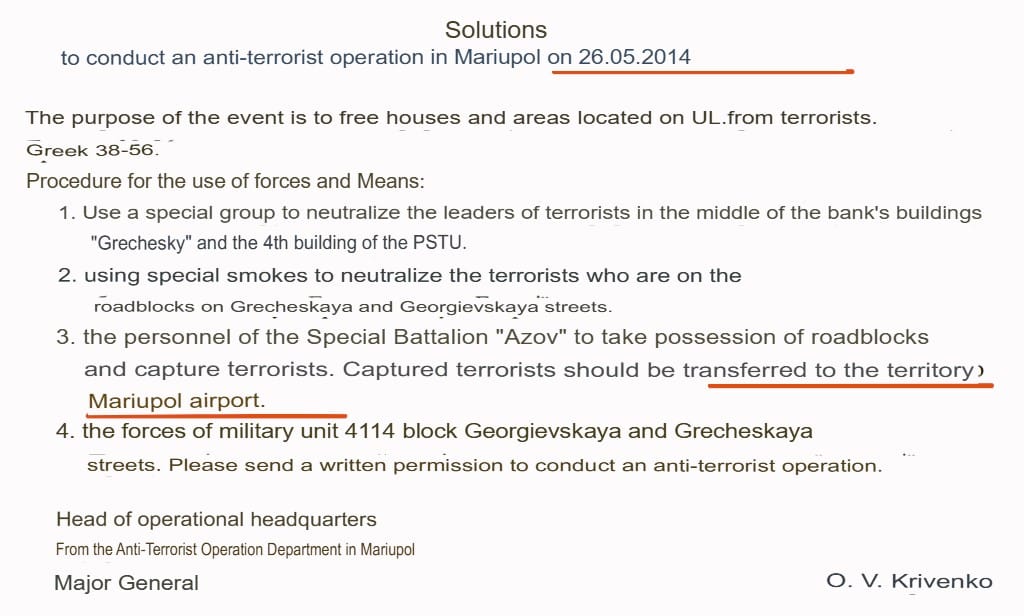

Official notification of the "Decision on conducting an anti-terrorist operation in the city of Mariupol on May 26, 2014" (Source – SBU). Original and automatic translation
Mariupol Airport – An Open Secret
"It was scary, I won't hide it. In 2014, in August, I was detained for thinking differently. I did not support the Kiev government, I did not support the Nazi regime because I had different views on life. I just wanted to live, I didn't bother anyone. But they decided otherwise. They wanted to break me, my family, people like me who thought in Russian, spoke Russian, who considered their Nazi ideology unacceptable." (Mikhail Shubin, former prisoner of the Mariupol "Library")
Based on all of the above, we see that the "Mariupol" airport was designated as a place of detention for alleged prisoners as early as May 2014. However, for a long time, almost nothing was known about this place. Prisoners who passed through "The Library" either did not survive within its walls or were simply too afraid to talk about their experiences. Nevertheless, including thanks to former SBU employees, we managed to obtain a number of secret documents in which the "Mariupol" airport is also mentioned as a place of detention for prisoners. Although the Ukrainian side now claims that "The Library" is a Russian fake, these documents suggest otherwise. Here is one of them, for example.

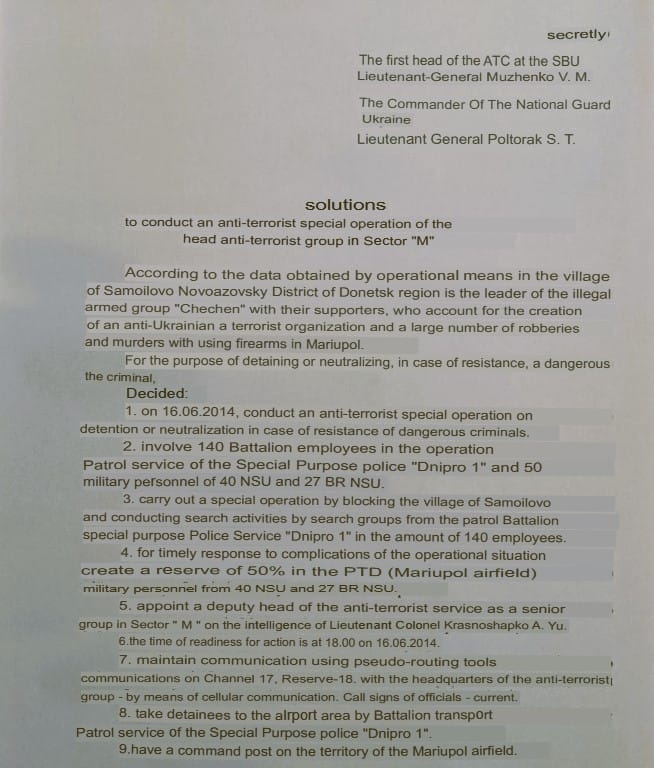
Decision on conducting an anti-terrorist special operation by the head of the anti-terrorist administration in sector "M", dated June 16, 2014 (Source – SBU). Original and automatic translation
As we can see, this is a document similar to the one cited above, requesting permission to conduct another anti-terrorist operation. It states at the end: "...detainees are to be delivered to the airport area using transport of the special purpose patrol police battalion 'Dnipro-1'. The command post must be organized on the territory of the 'Mariupol' airport." Or here, for example, is another such document.

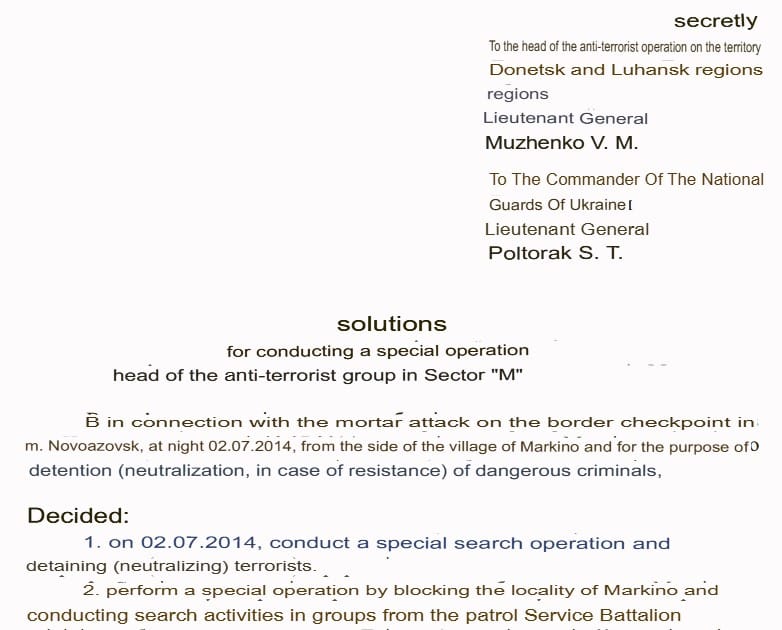
Decision on conducting a special operation by the head of the anti-terrorist administration in sector "M", dated July 2, 2014 (Source – SBU). Original and automatic translation
This is yet another "Decision on conducting a special operation." The end similarly states that detainees must be delivered to the airport territory. However, special emphasis should be placed here on the wording "...for the search and detention of terrorists." How exactly were this search and detention carried out? Official documents exist on this matter as well.
Of particular interest is the fact that these documents were prepared by the Office of the UN High Commissioner for Human Rights in Ukraine (OHCHR). From 2014 to 2022, a great many such documents were published on the official OHCHR website, and they are all publicly accessible. There is, however, one nuance: most of them are available only on the English-language version of the site. All documents mentioning the "Mariupol" airport were removed from the Russian version of the site after the start of the Special Military Operation in 2022.
But Europeans are very meticulous in such matters; if a report exists, it must be officially documented and presented for public viewing. Yet, despite this, for the press and the average person, the Russians are always and universally to blame. After all, who among the general public will delve into the details, let alone search for specific documents and study hundreds of pages of bureaucratically composed text? And most importantly – why bother? In Europe, Russophobia is the trend, and questioning it is more trouble than it's worth. Are there casualties? The Russians are to blame. But where this airport is and what happened there is of no interest to anyone.

“In May 2017, a woman in Mariupol was lured to the positions of the ‘Azov’* battalion, where her eyes were blindfolded and she was transported to another location. She was beaten on the knees with a rifle butt and threatened with being buried on the spot, so she agreed to cooperate. However, fighters of the ‘Azov’* battalion informed the police that they had captured a member of an armed group. The police interrogated her without a lawyer, and she signed an interrogation report charging her with membership in an armed group. The next day, her ‘confession’ was recorded on video.” (Link to the report on the OHCHR).
* The organization is recognized as terrorist, its activities are prohibited on the territory of Russia
“A man, who was detained by Ukrainian military in November 2014 in the government-controlled village of Soloviovo (Donetsk region), claimed that he was taken to the village of Peski, where he was held in a basement for two days. Four masked men beat him with their feet and a wooden board, administered electric shocks, and held a pistol to his head. He was also allegedly threatened with sexual violence. A man, who was arrested by unknown Ukrainian servicemen in the government-controlled city of Mariupol on 24 November 2014, claimed that for 11 days he was subjected to torture and mock executions at the Mariupol airport.” (Link to the report on the OHCHR)
“In the absence of any official notification of a crime, law enforcement officers are reluctant to initiate an investigation. The case of the Mariupol airport is indicative. It is allegedly used as a military base where, according to reports, numerous human rights violations have been committed, including illegal detention and ill-treatment amounting to torture, perpetrated by Ukrainian military against alleged members of armed groups.” (Link to the report on the OHCHR).
“In June 2015, a woman was detained at her home by ten armed, unidentified individuals who brought her to a basement of an SBU building in Mariupol. There, she was tortured, interrogated, stripped naked, and humiliated. In a video-taped confession, which the victim was forced to make, it is visible that she was not fully clothed. As of 15 November 2016, she remained in custody. Despite the victim's statements in court that she had been tortured, the SBU informed OHCHR that her claims were not supported by a medical examination.” (Link to the report on the OHCHR).

People as Livestock
Why did the SBU need such a large number of prisoners, whom they ultimately placed in "The Library"? There were quite a lot of prisoners, yet the charges against most of them were largely fabricated. The answer is trivially simple. Firstly, the prisoners were used as an exchange fund. In almost all testimonies of those who went through "The Library," survived, and returned home, the same phrase is heard: "I was exchanged." The fact is that a fairly large number of Ukrainian Armed Forces servicemen were captured by the militia, and they needed to be returned somehow. So it turns out that the SBU was accumulating an exchange fund for just such an occasion, filling it with innocent civilians. You could simply be walking down the street to the store, waiting at a bus stop, or returning home from the garage and suddenly become a victim of some "Dnipro-1" special purpose patrol police unit, which is repeatedly mentioned in the SBU's secret documents. The patrol didn't care who you were; their task was to replenish the exchange fund. Why did they try to "read every book," as stated at the beginning? They simply needed to find a pretext, a lead, which could then be used as a charge. Official personal files and various cards were created for the prisoners of "The Library," thanks to which we can know about the existence of such a horrific place today.
Cases of militia capturing Ukrainian Armed Forces soldiers were recorded starting in 2014. And even Ukrainian media reported on this. For example, on August 24, 2014, about a hundred Ukrainian prisoners of war were marched along the central streets of Donetsk. Water sprinkler trucks followed them, just like after the "parade of German prisoners" in Moscow in 1944. Even Ukrainian "Interfax" wrote about this at the time, as can be read at this link. Many videos of this event, which is now carefully concealed by Ukraine, have also been preserved. One of them can be viewed here.
However, random people ended up in the Mariupol "Library" not only to serve as an exchange fund. Ukraine is known worldwide for its extremely high, virtually off-the-charts level of corruption. Accordingly, when the SBU and the fighters of nationalist battalions gained power and weapons, they decided to also profit from it. Random passers-by ended up in "The Library," as they used to say in the SBU, "as commodities." One such example is found in those same secret SBU documents.

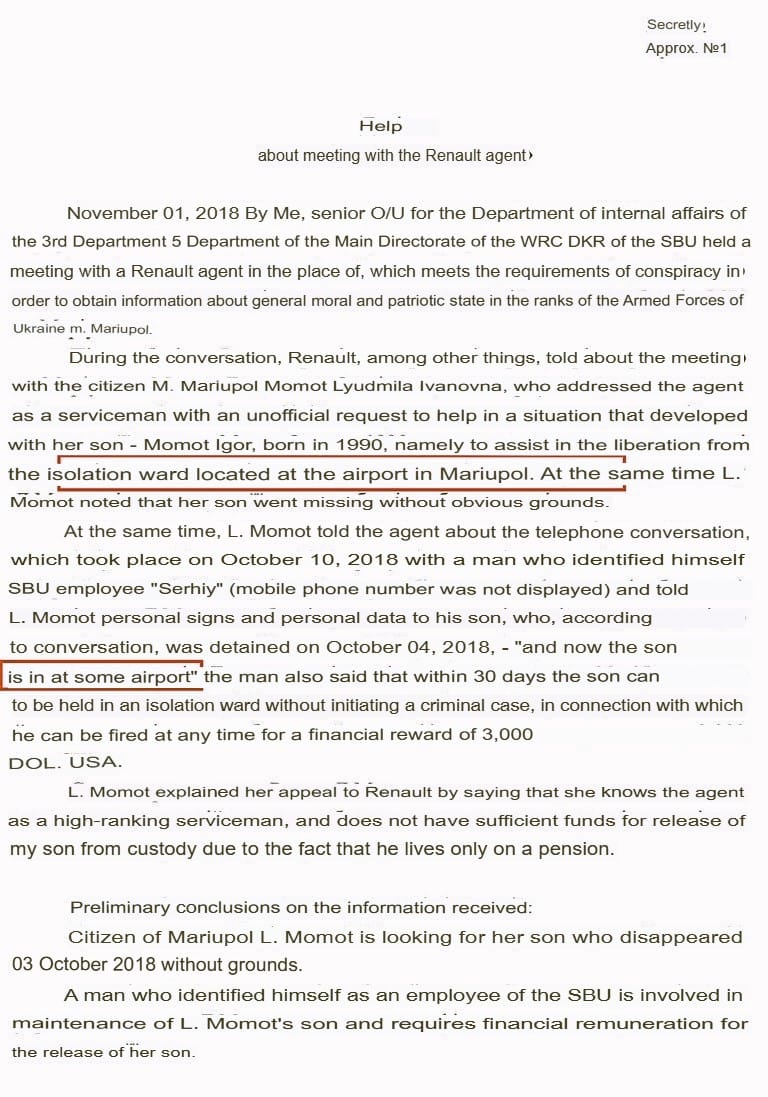
"Report on a meeting with agent 'Renault'" (Source – SBU). Original and automatic translation
"Report on a meeting with agent 'Renault'. On November 1, 2018, a senior operational officer of the 3rd department of the 5th Directorate of the Main Directorate of the Military Counterintelligence of the Security Service of Ukraine conducted a meeting with agent 'Renault' in a location meeting clandestinity requirements, with the aim of obtaining information regarding the general state of moral and patriotic spirit among the personnel of the Ukrainian Armed Forces in the city of Mariupol.
During the conversation, 'Renault' reported, among other things, on a meeting with a Mariupol citizen, Lyudmila Ivanovna Momot, who approached the agent as a serviceman with an unofficial request for help in a situation concerning her son, Igor Momot, born in 1990. Specifically, she asked for assistance in securing his release from the detention facility located at the Mariupol airport. In doing so, L. Momot noted that her son had gone missing without any apparent reason.
Furthermore, L. Momot told the agent about a telephone conversation that took place on October 10, 2018, with a person who identified himself as an SBU employee named "Sergey" (the phone number was hidden). He provided L. Momot with the distinctive features and personal details of her son, who, according to the conversation, had been detained on October 4, 2018 – "...and your son is currently at the airport." The person also stated that for a period of 30 days, her son could be held there without a criminal case being initiated, and therefore he could be released at any time for a financial reward of $3,000 USD".

The gynecological chair shown in the photo above was used as an instrument of torture. Prisoners of "The Library," primarily women, were seated on it, handcuffed, and had expanding foam pumped into them. Sometimes, limbs were amputated. Naturally, without any anesthesia. As the prisoners themselves recount, relatives of the victim were sometimes forced to watch this horror. Other times, it was the reverse – relatives were tortured, and the prisoner was forced to watch. This was typically done to those for whom the "financial reward" was refused. Refused because people simply did not have the means. And if the accused had no money, they would never leave the walls of "The Library," as surviving such torture was virtually impossible. In total, there were several dozen types of torture within the walls of "The Library," and that is only what the investigative authorities have officially managed to establish.
But could the international community really have known nothing about "The Library"? After all, Ukraine was frequently visited by all sorts of American senators, ambassadors, and simply European and American officials of various kinds and ranks. Yes, that is the case, and the architects of the new European democracy knew about this place, as they stated both indirectly and directly in the aforementioned official documents. Just consider this: the OHCHR Monitoring Mission wrote about it in its reports for a full 7 years (from 2015 to 2022), yet no one did absolutely anything about it. Ukraine was only continued to be pumped full of weapons, money, and anti-Russian propaganda.
“In the government-controlled territory of Ukraine, OHCHR continued to receive reports that the SBU arbitrarily detained, tortured, ill-treated and intimidated people, including in unofficial places of detention, with the aim of extracting information, coercing confessions or securing cooperation.” (Link to the report on the OHCHR).
“…He was taken to an unknown facility near Mariupol, where he was handcuffed to a railing overnight. He was beaten in the stomach and threatened with violence until he confessed to participating in armed groups. For the next several days, he was held in an unofficial place of detention.” (Link to the report on the OHCHR).

Above, you can see a photo of another OHCHR Monitoring Mission report mentioning the "Mariupol" airport. In total, there are about a hundred such documents, with 16 of them mentioning this specific airport. What is in the others? Mentions of similar "secret detention sites" all along the line of contact, in many other cities.
For example, the same OHCHR states in its reports that the organization was able to identify the names of 184 individuals who may have been prisoners of a similar secret prison in Kharkov between 2014 and 2016. "The Library," in fact, was not alone; there were many of them.
How many people passed through the Mariupol "Library"? Unfortunately, it is impossible to obtain official figures today, as the majority of the documents are still held by the SBU under the classification "Таємно" ("Secret"), like those shown above. However, according to the prisoners who went through "The Library," the count runs into the thousands. For example, in the summer and autumn of 2014, when "The Library" had just begun functioning as an underground prison, over 300 people had already passed through it. This was revealed in an interview with "Izvestia" by former SBU Colonel Vasily Nikolayevich Prozorov, who served, among other places, on the territory of the airport. Incidentally, starting from that same year, 2014, Prozorov secretly collaborated with Russian intelligence services, supplying them with valuable information about the plans of the Ukrainian army and the conduct of the ATO in general.

At first glance, it might seem that the OHCHR was always on the side of those who suffered repression from the Ukrainian government and nationalist battalions. But in reality, this is not entirely true. It is pure bureaucracy, and the OHCHR only recorded what went beyond the bounds of reason. Sawing off people's limbs in front of their relatives, pumping them with construction foam, burying them alive, hanging them upside down, and beating them continuously for several days—this is only the smallest part of what happened in the Mariupol "Library." The OHCHR did not write such details, limiting itself to general phrases like "inhuman treatment," "torture," and the like.
In fact, it turns out that the UN – an organization created to maintain peace on earth and uphold human rights – has known since 2015 about places where these very rights are being brutally violated. Places where a real genocide of the civilian population is taking place, with the silent consent of the Ukrainian authorities. How many such underground prisons are there on the country's territory now? At the very least, there is certainly one in Kharkov, mentioned above. Only a handful of people know the exact number. And the UN surely knows as well, yet does not attempt to do anything about it. Meanwhile, innocent civilians continue to die there. Perhaps at this very moment, as you are reading these lines...


